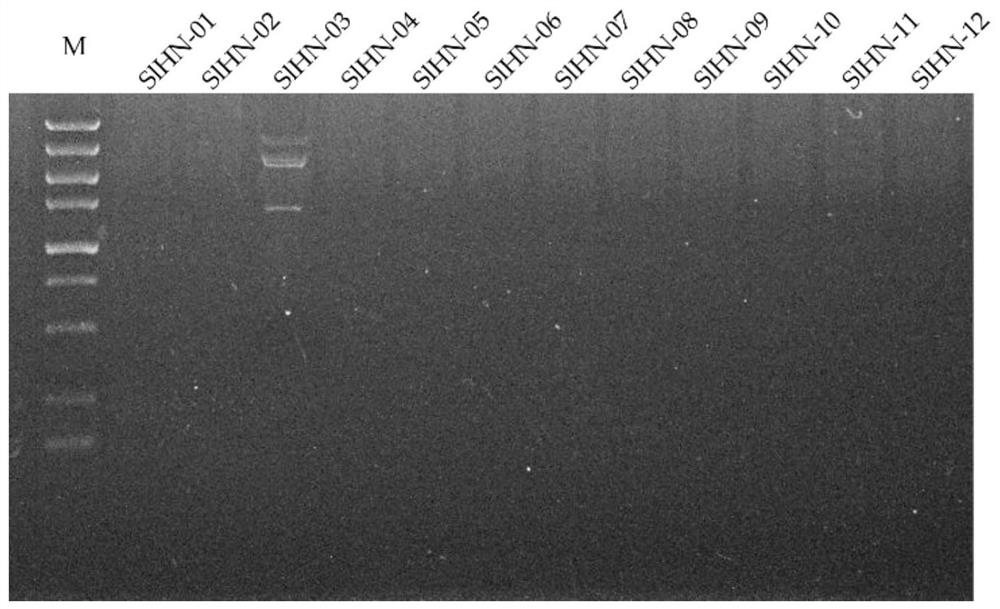A kind of mycovirus slmv1, attenuated bacterial strain and application
A technology of fungal viruses and strains, applied in the direction of viruses/bacteriophages, viruses, applications, etc., can solve the problems of continuous emergence of resistance and reduced efficacy of pharmaceuticals
- Summary
- Abstract
- Description
- Claims
- Application Information
AI Technical Summary
Problems solved by technology
Method used
Image
Examples
preparation example Construction
[0052]
[0053] The mycovirus S1MV1 of the present invention is present in a predetermined Puccinia strain, and therefore, the mycovirus can be obtained by isolating and recovering the virus from a Puccinia strain infected with the mycovirus.
[0054] Known methods can be used as methods for isolating and recovering viruses. For example, the bacterial cells can be frozen and crushed with liquid nitrogen, suspended in a predetermined buffer, and the virus can be isolated by ultracentrifugation, etc., and the virus can be recovered.
[0055] However, the mycovirus of the present invention may also exist outside the cells of the host bacteria. Therefore, for example, a phytopathogenic fungus infected with a mycovirus can be cultured in a liquid medium or the like, and the bacteria can be isolated by centrifugation, and then the virus can be isolated and recovered from the culture supernatant, whereby the virus can be recovered easily and in a relatively large amount.
[0056] ...
Embodiment 1
[0070] The preparation of embodiment 1 bacterial strain S1HN-03 of the present invention
[0071] Pick lettuce leaves with leaf spot disease from Changsha Vegetable Base in Hunan Province, use conventional tissue separation method, take the tissue at the junction of diseased and healthy leaves for separation, soak in mercuric chloride for 1 min, 70% alcohol for 5-8 seconds, rinse with sterile water three times, and then dry , transferred to a PDA plate, and cultured upside down at 28°C; after the growth of mycelium, the strain was inoculated on V8 medium (V8 fruit juice 200g, CaCO33.0g, agar 20g, supplemented with deionized water to 1L), and placed in the light Cultivate under alternating dark conditions, and after 10 days, pick the slow-growing hyphae of the colonies and transfer them to a new PDA plate. Continue to cultivate under 28 ℃ of alternating light and dark conditions, observe under a microscope for 10 days, pick a single spore on a new PDA plate, and the newly grown b...
Embodiment 2
[0072] The detection of internal double-stranded RNA of embodiment 2 bacterial strains
[0073] Intrinsic double-stranded RNA was detected from 12 strains of P. tomato from S1HN-01 to S1HN-12 of strain S1HN-03 of the present invention. Firstly, the 12 strains of Puccinia spp. that were isolated and cultured were ground, and the nucleic acid was extracted by the phenol SDS method, and DNA and single-stranded nucleic acid were selectively decomposed by DNase1 and S1 nuclease to obtain double-stranded RNA in the bacteria. Then, electrophoresis was performed on a 1% agarose gel at 120 V for 0.5 hour, and staining was performed with ethidium bromide.
[0074] see results figure 2 , the results showed that among the 12 bacterial strains, except that the bacterial strain SlHN-03 contained 4 double-stranded RNA bands of 1.4-3.6kb, the remaining 11 bacterial strains were all normal or conventional Puccinia tomato (without double-stranded RNA), However, mycoviruses have never been re...
PUM
 Login to View More
Login to View More Abstract
Description
Claims
Application Information
 Login to View More
Login to View More - R&D
- Intellectual Property
- Life Sciences
- Materials
- Tech Scout
- Unparalleled Data Quality
- Higher Quality Content
- 60% Fewer Hallucinations
Browse by: Latest US Patents, China's latest patents, Technical Efficacy Thesaurus, Application Domain, Technology Topic, Popular Technical Reports.
© 2025 PatSnap. All rights reserved.Legal|Privacy policy|Modern Slavery Act Transparency Statement|Sitemap|About US| Contact US: help@patsnap.com



